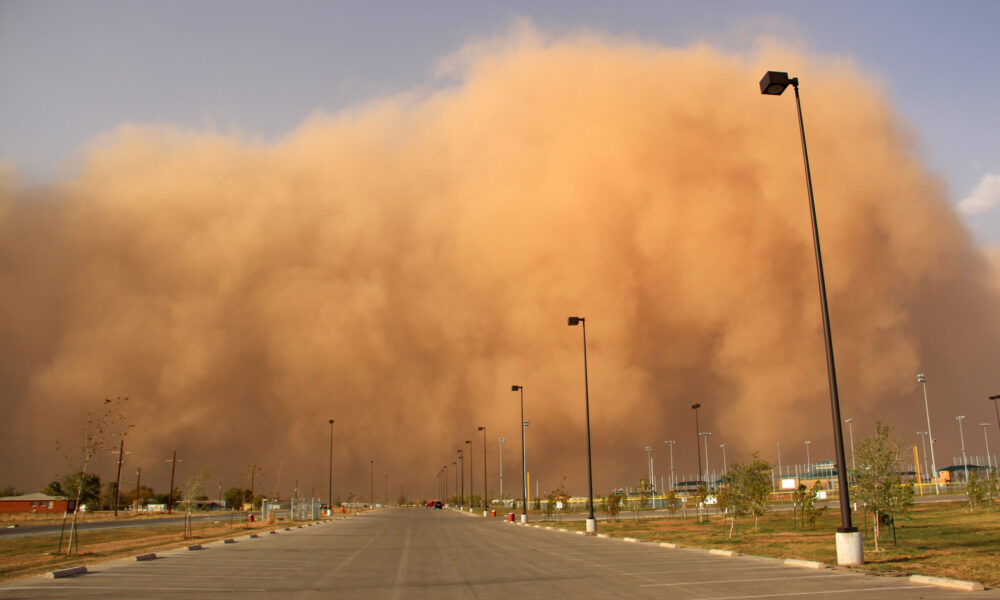On a stretch of interstate highway in central Illinois last week, a freak dust storm caused a series of massive vehicle pileups that killed seven people and injured dozens more. The cause of the tragedy, according to Illinois State Police, was “excessive winds blowing dirt from farm fields across the highway leading to zero visibility.” News reports noted that dust storms are rare in Illinois, but drier, hotter conditions in many farming communities could make such events more frequent and deadly. This disaster should serve as a sobering reminder that policymakers and the agriculture industry need to do more to adapt to our changing climate.
A new Dust Bowl? When soil erosion and climate change collide
We’ve all seen grainy historical photos of the Dust Bowl of the 1930s—a nearly decade-long confluence of recurring severe droughts, poor farming practices, and plummeting grain prices that devastated much of the Great Plains and drove the largest migration in US history. That time now feels remote, and a repeat catastrophe of that magnitude seems unthinkable. But the loss of life on an Illinois highway last week wasn’t just shocking and tragic, it was also a warning.
Because like the Dust Bowl of so many decades ago, this tragedy stemmed from a collision of multiple systemic problems—in this case, unchecked climate change layered atop the excesses of industrial agriculture. Atmospheric conditions produced unusually strong winds in the area that day, but the wind alone couldn’t have caused the catastrophe without the combined effects of exceptional dryness and newly disturbed bare soil. A US Department of Agriculture (USDA) official noted that farm fields in the area had been tilled for planting or had just been planted, leaving soil exposed, and that topsoil “was primed to be lofted into the air by short-term dryness.” That part of central Illinois had received roughly half the normal rainfall for April.
A devastating dust storm is just one of many bad outcomes that are possible when increasingly severe weather interacts with an agriculture system that doesn’t value and protect the soil that is its literal foundation.
Although most people don’t notice it, erosion and soil degradation caused by industrial agriculture are already a problem in farming regions across the country. According to a 2020 Union of Concerned Scientists (UCS) report, every year, US croplands lose at least twice as much soil to erosion as the Great Plains are estimated to have lost annually during the peak of the Dust Bowl. Using recent estimates from the USDA, we projected that croplands would lose an additional 28 billion tons of soil by 2035 and 148 billion tons by 2100—about 300 years’ worth at the rate at which soil naturally forms.
As climate change continues and farming areas get hotter and drier—as expected in the Southern Great Plains and Southwest—erosion could increasingly take the form of dust storms when bone-dry fields are plowed. In Illinois and the rest of the Corn Belt, weather patterns may ping-pong between wet and dry, but the overall Midwest prediction calls for an increase in extreme precipitation and heavy flooding. And very wet conditions bring their own soil loss problems, because . . .
Soil doesn’t just blow away—it also washes away and pollutes our water
Extreme precipitation and flooding carry large quantities of soil off bare farm fields. Coupled with excessive use of fertilizer, which has increased dramatically over the last four decades, this creates major water-quality problems, as the fertilizer runs off into waterways and leaches into groundwater. The results range from localized drinking water contamination to ecological and economic damage in water bodies far from the source of the pollution.
A 2021 UCS study quantified the impact of nitrates—a by-product of nitrogen-based fertilizers—in drinking water in Iowa, a state heavily impacted by farm runoff. It found that in 2020, 58 of Iowa’s public water systems treated 82 billion gallons of drinking water for nitrates, which can cause serious health problems such as neural tube defects in utero and “blue baby syndrome” in infants. Chronic exposure to nitrates at lower levels is also associated with increased risk for some cancers. In Iowa, it’s estimated that up to 300 cases of cancer each year are caused by exposure to nitrates in drinking water. And treating water to remove nitrates is expensive: UCS estimated that it will cost Iowans between $41 million and $333 million over the next five years—much of which will be borne by small rural communities.
Fertilizer runoff can also affect urban communities downstream. Toxic algae blooms in Lake Erie are now an annual event that is predicted and tracked and has forced residents of Toledo, Ohio, to resort to bottled water. For three full days in 2014, nearly half a million people were told their tap water was unsafe to drink, bathe in, or even touch. Last year’s bloom was more toxic than predicted, lasted longer than previous years, and covered 416 square miles of the lake at its peak. A 2022 report that assessed data from the Ohio Environmental Protection Agency showed that monitoring and treating algae-contaminated water from Lake Erie costs Toledo roughly $100 per family per year, a cost passed on in residents’ water bills.
Pollution from unsustainable farming and soil management practices is also a major problem in rivers in Illinois and other farming states. Climate change is making the problem worse, with a 2022 study finding that warming winters put water quality at greater risk in more than 40 states, as “rain-on-snow” flooding events wash large amounts of fertilizer into lakes, rivers, and streams.
Ultimately, a huge amount of soil and fertilizers from the Midwest washes down the Mississippi River into the Gulf of Mexico, where every summer it triggers a large “dead zone”—an area of coastal water so low in oxygen that nothing can live there. It’s a recurring ecological disaster that causes hardship for people who make their living from fishing, shrimping, and tourism. This problem will likely worsen with climate change, as heavier spring rains unleash more soil runoff and warmer Gulf waters make the effects of the pollution worse.
The answer? Smart practices and policies that protect farm soils
The Illinois dust storm disaster received extensive media attention, but little of the coverage examined the potential for solutions. Preventing soil loss from farms and its damaging consequences is possible, and it starts with keeping farm soils covered. All the time. Farmers can adopt science-based practices such as planting cover crops in the off season, reducing or avoiding tillage (plowing), diversifying crops to incorporate more deep-rooted perennial plants that hold soil in place, and preventing livestock from overgrazing. These practices build up soil health so less of it blows away or runs off. It’s a win-win for farmers and communities.
These practices have other benefits as well. Studies have overwhelmingly found that soils kept covered and unplowed absorb more water during heavy rains and hold onto more of it longer during dry periods. Scientists call that improved water infiltration, and it helps farmers get through weather extremes with less damage to their fields and crops. If less flood and drought damage leads to fewer and smaller claims filed against the federal crop insurance program, that also saves taxpayers money. And when farmers protect their soil, they also store more carbon (that would otherwise heat the atmosphere) and safeguard the foundation of our food supply.
Enter the Agriculture Resilience Act, or ARA. As my colleague recently wrote on this blog, this science-based bill would go a long way to helping farmers overcome barriers to widespread adoption of soil-saving practices. It would expand funding to underwrite and incentivize investments in new seed and equipment and expand training and technical assistance. And it would fund more research to help farmers optimize soil-improving practices for the specific crops, soils, and weather conditions they must work with.
This legislation is gaining support from farmers and farm groups—its sponsor, Representative Chellie Pingree of Maine, is an organic farmer herself. And many of the bill’s provisions align with a February 2023 report from the US Government Accountability Office that recommended ways the USDA could enhance farmers’ resilience to climate change and limit climate-related costs that taxpayers are forced to bear.
The ARA can be an important part of a larger food and farm bill that improves soil and water quality (helping to prevent tragedies like the one in Illinois), is better for consumers and workers, puts US agriculture on a path to net-zero climate emissions, and much more.
You can lend your voice to the call for Congress to incorporate the ARA into the next food and farm bill here.

